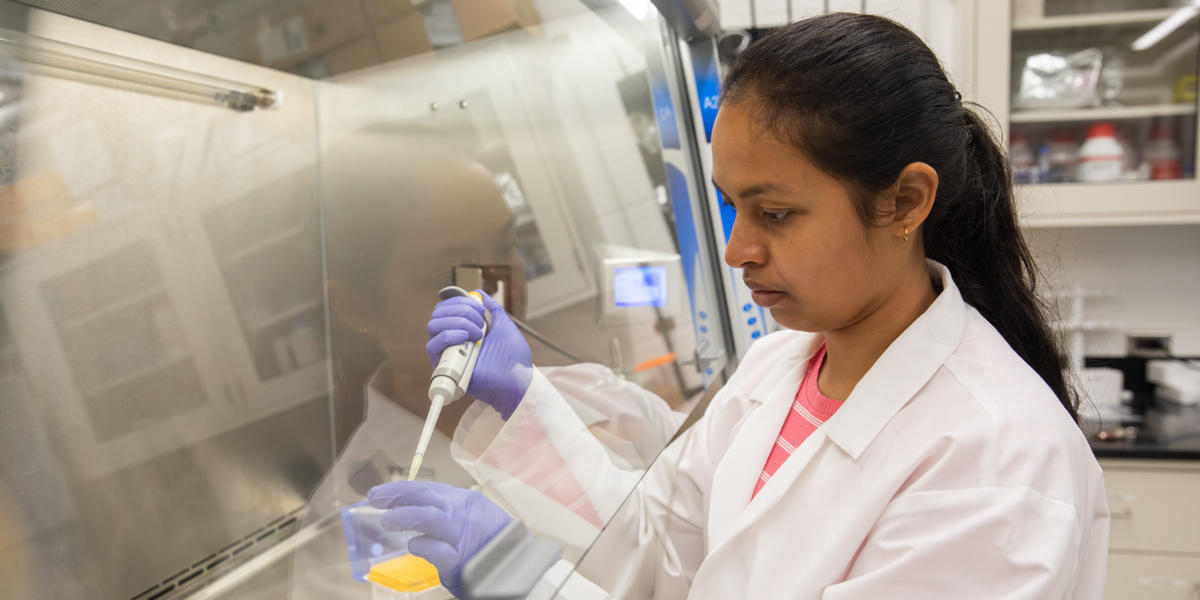
PhD student Vinni Thekkudan Novi tests a new assay to detect the oak wilt pathogen
Background
Oak wilt (Bretziella fagacearum) is a fungal disease affecting oak species in 25 counties across the state. For tree removal costs alone, Minnesotans paid an estimated $60 million in the past decade because of this disease.
The key to oak wilt is spotting the problem before it’s too late. When infection is caught early, managers can take action to lower the risk of spread. But it can be weeks before visible signs appear, and symptoms are easy to confuse with damage from drought, pests or other diseases.
Project phases
Lab testing has been a mainstay for reliable oak wilt diagnosis, but the process can be slow, expensive and susceptible to contamination. This project recognizes the urgent need for faster, more affordable diagnosis of oak wilt in the field. The team worked on developing a handheld reader to allow managers to detect oak wilt from wood chips within one hour at low cost.
Research questions
- Can DNA receptors specific to the oak wilt fungus, B. fagacearum, be used to detect infection in real samples?
- Can DNA identification technology be adapted into a handheld portable field device for rapid disease detection?
After developing new rapid detection technology that successfully detects the pathogen that causes oak wilt, researchers tested the new technology with other priority invasive forest pathogens. This includes Dutch elm disease, Annosum root rot, bur oak blight, and cankers in black walnut trees.
Research questions
- How can we best develop new DNA probes and apply the assay to other forest pathogens?
- What are the outcomes of testing the new technology with stakeholders?
Outcomes
This research team developed a new, patented assay that allows rapid detection of the fungus Bretziella fagacearum that causes oak wilt disease. The assay was validated using B. fagacearum, however it could be validated for use on other pathogens.
The new technology combines a specific DNA amplification using Loop-Mediated Isothermal Amplification (LAMP) and a DNA amplicon visualization using nanoparticle assembly. Results of the assay can be seen with the naked eye within 30 minutes. The assay has excellent sensitivity (100%), specificity (100%), and eliminates the possibility of false positives and negatives.
The assay may become available commercially. Being able to detect invasive forest pathogens early will have a significant economic impact by preventing the spread of diseases and the conservation of natural resources.
Publications
- Naked-eye visualization of nucleic acid amplicons using hierarchical nanoassembly (Analytical Methods, 2023)
- Use of Sodium Hydroxide DNA Extraction Methods for Nested PCR Detection of Bretziella fagacearum in the Sapwood of Oak Species in Minnesota (Plant Health Progress, 2022)
- Microbial separation from a complex matrix by a hand-held microfluidic device (Chemical Communications, 2017)
- Rapid and PCR-free DNA Detection by Nanoaggregation-Enhanced Chemiluminescence (Nature Scientific Reports, 2017)
Outreach
- Recording of presentation at the Invasive Species Forum, 2024
- American Institute of Chemical Engineers (AIChE) Annual Meeting, 2023
- American Chemical Society Fall Meeting, 2023
- World Congress of Biosensors, 2018
- Atlantic Basin Conference on Chemistry, 2018
- ASABE Annual International Meeting, 2018
News and media
- Innovations for oak wilt detection and containment (MITPPC, 2023)
- Researchers use green gold to rapidly detect and identify harmful bacteria (Manufacturing.net, 2018)
- New tech may speed up Oak wilt detection (Kare 11, November 2017)
- University researchers develop tree disease detection device (The Minnesota Daily, November 2017)
- New technology makes oak wilt detection faster, more affordable (USDA Echo Journal, November 2017)
- Top 100 in Chemistry for the paper “Rapid and PCR-free DNA Detection by Nanoaggregation-Enhanced Chemiluminescence” (Nature’s Scientific Reports, 2017)